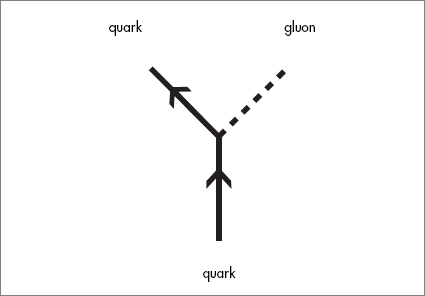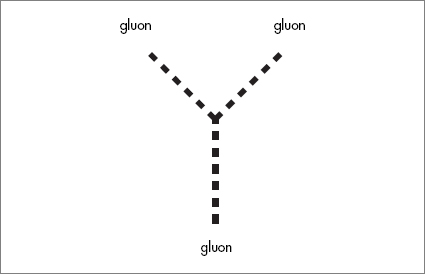The Cosmic Landscape (9 page)

Many years ago I was invited to a famous university to give a series of lectures on a brand-new subject called Quantum Chromodynamics (QCD). As I was walking through the halls of the Physics Department on my way to the first lecture, I overheard a pair of graduate students discussing the title. One, who was looking at the lecture announcement on the bulletin board, said, “What’s this all about? What is Quantum Chromodynamics?” The other fellow thought for a moment, then looked up and said, “Hmmm, it must be a new way to use quantum mechanics to develop your photographs.”
Quantum Chromodynamics has nothing to do with photography or even light. QCD is the modern version of nuclear physics. Conventional nuclear physics begins with protons and neutrons (nucleons), but QCD goes a step deeper. It’s been known for forty years that nucleons are not elementary particles. They are more like atoms or molecules except on a much smaller scale. If one could look into a proton with a sufficiently powerful microscope, one would see three quarks tied together by a string of particles called
gluons.
The theory of quarks and gluons—QCD—is a more complicated theory than QED, and I won’t really be able to do it justice in a few pages. But the basic facts are not too difficult. Here is the cast of characters.
The Six Quarks
First there are the quarks: there are six distinct types of them. In order to distinguish one from another, physicists gave them meaningless, whimsical names: up-quark, down-quark, strange-quark, charmed-quark, bottom-quark, and top-quark, or more concisely, u-, d-, s-, c-, b-, and t-quarks. There is, of course, nothing stranger about the strange-quark or more charming about the charmed-quark, but the silly names give them a bit of personality.
Why are there six quark types and not four or two? Who knows? A theory with four or two types of quarks is every bit as consistent as one with six types. What we do know is that the mathematics of the Standard Model requires the quarks to come in pairs—up with down, charmed with strange, and top with bottom. But the reason for the threefold replication of the simplest theory—one with only up- and down-quarks—is a complete mystery. To make matters worse, only the up- and down-quarks play any essential role in ordinary nuclei.
15
If QCD were an engineering project, the rest of the quarks would be considered an extravagant squandering of resources.
Quarks are in some ways similar to electrons, although somewhat heavier, and they have peculiar electric charges. In order to have a basis for comparison, the charge of the proton is traditionally taken to be one (+1). The electron’s charge is equally big but opposite in sign (–1). Quarks, on the other hand, have charges that are fractions of the proton charge. In particular, the charges of the u-, c-, and t-quarks are positive like the proton’s but only two-thirds as big (
2
/
3
). The d-, s-, and b-quarks have negative charges equal to one-third the electron charge (
–
1
/
3
).
Both protons and neutrons contain three quarks. In the case of the proton, there are two u-quarks and a single d-quark. Adding up the electric charges of these three quarks, the result is the charge of the proton:

The neutron is very similar to the proton, the difference being that the up- and down-quarks are interchanged. Thus, the neutron contains two d-quarks and one u-quark. Again adding the three charges, we find the neutron has (as expected) no electric charge:

What would happen if we tried to build a proton, or something like a proton, by substituting a strange-quark for the down-quark? Such objects do exist—they are called
strange particles
—but they don’t exist anywhere except in physics laboratories. Even in such laboratories strange particles are fleeting occurrences that last for no more than a tiny fraction of a second before disintegrating by a kind of radioactivity. The same is true of particles containing charmed-, bottom-, or top-quarks. Only up- and down-quarks can be assembled into stable, long-lasting objects. As I said, if the strange-, charmed-, bottom-, and top-quarks were suddenly removed from the list of elementary particles, hardly anyone would notice.
What about quarks that go backward in time? Like electrons, each kind of quark has its antiparticle. They can be assembled into antiprotons and antineutrons. At one time very early in the history of the universe, when the temperature was billions of degrees, antinucleons were about as abundant as ordinary nucleons. But as things cooled, the antiparticles almost entirely disappeared, leaving only the ordinary protons and neutrons to form the nuclei of atoms.
The Gluon
Nucleons are like tiny atoms made of quarks. But quarks alone would be powerless to bind themselves into nucleons. Like the atom, they require another ingredient to create the forces of attraction that “glue” them together. In the case of the atom, we know exactly what the glue is. The atom is held from flying apart by photons continuously being juggled back and forth between electrons and nuclei. But the force generated by photon exchange is far too weak to bind quarks into the tightly knit structure of a nucleon (remember that nucleons are 100,000 times smaller than atoms). Another particle with more potent properties is needed to pull quarks together that tightly. That particle is the aptly named gluon.
The basic events in any quantum field theory are always the same: the emission of particles by other particles. The Feynman diagrams describing these events always have the same form: vertex diagrams shaped like the letter Y. The basic vertex diagram for QCD looks exactly like the photon-emission vertex with a quark replacing the electron and a gluon taking the place of the photon.
Not surprisingly, the origin of the forces that bind quarks into protons and neutrons is the exchange of gluons. But there are two big differences between QED and QCD. The first is a quantitative difference: the numerical constant governing the emission of gluons is not as small as the fine structure constant. It is called α
QCD
(alpha-QCD) and is about one hundred times larger than the fine structure constant. This is the reason that the force between quarks is much stronger than the electric force that acts in the atom. QCD is sometimes called the theory of the
strong interactions.

The second difference is qualitative. It causes gluons to become a sticky substance that always reminds me of the tale of the tar baby. Once upon a time, according to southern folklore, Brer Rabbit
16
came upon a tar baby sitting in the road, minding his own business. Brer Rabbit said, “Mornin’.” The tar baby said nothing. Brer Rabbit got offended. One thing led to another, and soon an altercation ensued—Brer Rabbit got mad and punched tar baby, but that was a huge mistake. Stuck with his fist in the tar, Brer Rabbit pulled and pulled, but the tar just stretched and pulled him back. As hard as he struggled to free him himself, tar baby just wouldn’t let go.
Why the tar baby story? Because quarks are miniature tar babies, but only to other quarks. They are permanently glued together by a tarlike, stringy substance made of gluons. The origin of this strange behavior is one extra vertex that has no analog in QED. Any electrically charged particle can emit a photon. But photons themselves are not charged. They are electrically neutral and, therefore, will not emit another photon. In this respect gluons are very different from photons. The laws of QCD require a vertex in which a gluon splits into two gluons, each proceeding on one of the paths of the fork.

This is the big difference between QCD and QED that makes QCD a far more complicated theory than its electric counterpart. Among other things, it implies that gluons can exchange gluons and bind into objects called glueballs—particles with no quarks or electrons at all. In fact gluons don’t stick together only in pairs. They can form long chains of stringy glue. Earlier I likened the electrons in an atom to balls being swung on ropes. In that case the rope was entirely metaphorical. But in the case of quarks, the strings holding them together are quite real. They are strings of gluons strung out between the quarks. In fact when a quark is forcibly ejected from a nucleon, a long string of gluons forms and eventually prevents the quark’s escape.
If you are getting weary of learning particle physics, I don’t blame you. It’s too complicated with too many things to remember. There are too many particles to keep track of and no good reason that we know of for their existence. QCD and QED hardly exhaust the pieces that make up the Standard Model. The whole thing is a very far cry from the elegant simple theory that physicists expected to find “at the bottom of it all.” It’s a good deal more like zoology or botany. But that’s just the way it is. We can’t change the facts.
I am going to guide you through one more piece of the Standard Model: that part known as the
weak interactions.
Like QED and QCD the weak interactions play an important role in explaining our own existence, although the reasons are subtler and won’t become clear until later chapters.
The history of the weak interactions dates back to the very end of the nineteenth century, when the French physicist Antoine-Henri Becquerel discovered radioactivity. Becquerel’s discovery preceded J. J. Thomson’s discovery of the electron by one year.
Radioactivity comes in three different kinds, called alpha, beta, and gamma. They correspond to three very different phenomena, only one of which (beta) has to do with the weak interactions. Today we know that the
beta rays
coming from Becquerel’s uranium sample were actually electrons emitted by neutrons in the uranium nucleus. Upon emitting the electron, the neutron immediately turns into a proton.
Nothing in either QED or QCD explains how a neutron can emit an electron and become a proton. The simplest explanation, which may already have occurred to you, is that there is an additional vertex diagram to add to our list of fundamental events. The vertex would involve an initial neutron coming to a fork in the road, whereupon a proton would continue on one path and an electron on the other. But this is not the correct explanation. The fact is that a new character is about to make its entrance—the neutrino. What Becquerel didn’t know was that another particle flew off when the neutron decayed, namely, the antiparticle of the ghostly neutrino.
